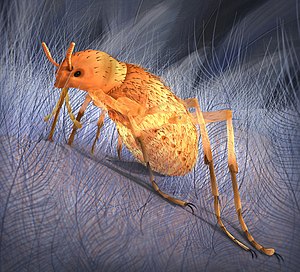Pseudopulex
| Pseudopulex | ||||||||||||
|---|---|---|---|---|---|---|---|---|---|---|---|---|

Pseudopulex |
||||||||||||
| Temporal occurrence | ||||||||||||
| Middle Jurassic to Lower Cretaceous | ||||||||||||
| 163.5 to 126.3 million years | ||||||||||||
| Locations | ||||||||||||
|
||||||||||||
| Systematics | ||||||||||||
|
||||||||||||
| Scientific name of the family | ||||||||||||
| Pseudopulicidae | ||||||||||||
| Gao , Shih , Xu , Wang , & Ren , 2012 | ||||||||||||
| Scientific name of the genus | ||||||||||||
| Pseudopulex | ||||||||||||
| Gao , Shih , Xu , Wang , & Ren , 2012 |
Pseudopulex is an extinct genus of insects from the Mesozoic era . These insects probably lived parasitically on the blood of large pinnate or hairy terrestrial vertebrates, e.g. B. dinosaurs , pterosaurs or earlier mammals . Well-preserved fossils have been found in China in the Inner Mongolia area . The genus name is a combination of ancient Greek ψεῦδος nick name , lies, deception, fraud 'and lat. Pulex , flea'.
So far, two species have been described, Pseudopulex jurassicus from the Jurassic Jiulongshan Formation (about 165 million years old) and P. magnus , from the 130 to 120 million year old Yixian Formation of the early Cretaceous ( Barremium / Lower Aptian ).
features
Pseudopulex was 17 to 22.8 mm long without a antenna . The insects had bodies covered with stiff, backward-pointing bristles, short antennae with more than 15 segments, reduced eyes, powerful, stiletto-like , sawn mouthparts , sickle-shaped claws on the pretarsus and cone-like spines on the rails ( tibia ). Wings were missing. The mouthparts were twice as long as the head (about 3.4 to 5.2 mm).
Systematics
In their characteristics they resemble fleas (Siphonaptera), especially the primitive sand fleas (Tungidae). However, Pseudopulex did not have the ankle bones typical of fleas and their bodies were not flattened on the sides. Since no diagnostic features could be determined for a classification within the fleas, Pseudopulex is placed in the newly established family Pseudopulicidae, which is currently incertae sedis (without classification) within the insects .
Way of life
The fossils of small, feathered dinosaurs (11.6 to 220 cm long), pterosaurs (60 to 240 cm long), birds (15 to 60 cm long) and early mammals (5 to 68 cm long) were found in the sites of both Pseudopulex species cm long) found.
Because of the size of the Pseudopulex species and their long mouthparts, it is considered unlikely that small mammals or birds were victims of the parasites. Larger feathered dinosaurs, pterosaurs or medium-sized mammals (only from the Lower Cretaceous), on the other hand, were ideal host animals . Pseudopulex was able to hold onto the plumage or fur of the victims with its strong, clawed legs. Since they could neither jump nor run well, the insects probably had to spend a large part of their life on a single individual, possibly almost permanently stuck.
It is possible that the ectoparasitic way of life of fleas evolved on feathered dinosaurs or pterosaurs and the insects later switched to smaller hosts (mammals and birds) and adapted to them by reducing body size and shortening the mouthparts.
literature
- Tai-ping Gao, Chung-kun Shih, Xing Xu, Shuo Wang, Dong Ren: Mid-Mesozoic Flea-like Ectoparasites of Feathered or Haired Vertebrates . In: Current Biology 22 (8), 2012, pp. 732-735. doi : 10.1016 / j.cub.2012.03.012
Individual evidence
- ^ Wilhelm Gemoll : Greek-German school and hand dictionary . G. Freytag Verlag / Hölder-Pichler-Tempsky, Munich / Vienna 1965.
- ↑ Erich Pertsch: Langenscheidts Large School Dictionary Latin-German . Langenscheidt, Berlin 1978, ISBN 3-468-07201-5 .